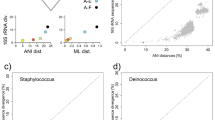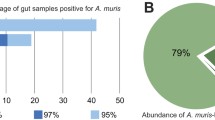Abstract
When the first reports of 16S rRNA sequence analysis were published about 20 years ago, the potential of ribosomal RNA species for studies in evolution, phylogeny, systematics and identification [47] and ecology [28, 29] were far from being fully acknowledged. What started with short sequences from a limited range of pro- and eukaryotic species turned out to revolutionize our understanding of (i) the origin of life on the planet Earth, (ii) the development of unknown, ancient, ancestral forms into main lineages leading to extant organisms such as Bacteria, Archaea and Eukaryotes, (iii) the relatedness among recently evolved species, and (iv) the richness of microbial forms in the environment. The results obtained have not only resusciated interest in the work of systematists, but have stimulated the cooperative work of researchers from different disciplines. Both, microbial taxonomy and microbial ecology have revived from Sleeping Beauty-types, somewhat boring fields into exciting disciplines in which objectivity has replaced decades of subjective judgement of facts. Molecular biology, using techniques such as PCR amplification, cloning, sequencing, hybridization and probing has finally been fully accepted by these disciplines. Organisms known to exist as symbionts and parasites were suddenly available for further characterization, and the extent of living but uncultured microorganisms became obvious without, however, allowing an estimation of the order of magnitude with which these dormant forms exceed the culturable organisms. In the past, uncultured strains have been observed in natural samples solely by light and electron microscopy. The determination of phylogenetic relationships of some these obligately inter- and intracellular organisms has been one of the scientific highlights in the eighties. Using the cataloguing approach, the task was easy when the symbiont occurred abundantly as an almost pure culture, as in the case of Prochloron species within their ascidian (Didemnid) hosts [38]. The reverse transcriptase technique of 16S rRNA sequencing was used to determine the phylogeny of the extremely slow growing pathogenic organism Mycobacterium leprae [39], but the main breakthrough occurred recently when the 16S rDNA of small numbers of cells could be amplified by the PCR approach and sequenced, either directly or following a cloning step. Examples are symbionts of shipworms [8], Holospora [1], the nematode lysing Pasteuria penetrans [Stackebrandt, Dorsch and Paschke, unpublished], the giant fish bacterium [2], Buchnera species which are symbions of aphids [43] or the methanogenic symbionts of anaerobic ciliates [11].
Access this chapter
Tax calculation will be finalised at checkout
Purchases are for personal use only
Preview
Unable to display preview. Download preview PDF.
Similar content being viewed by others
Refrences
Amann RI, Springer N, Ludwig W, Görtz H-D, Schleifer K-H (1991) Identification in situ phylogeny of uncultured bacterial endosymbionts. Nature 351: 161–164.
Angert ER, Clements KD, Pace NR (1993) The largest bacterium. Nature 362: 239–241.
Barns SM, Fundyga RE, Jeffries MW, Pace NR (1994) Remarkable archaeal diversity detected in a Yellowstone National Park hot spring environment. Proc Natl Acad Sci USA 91: 1609–1613.
Britschgi T, Giovannoni SJ (1991) Phylogenetic analysis of a natural marine bacterioplankton population by rRNA gene cloning and sequencing. Appl Environ Microbiol 57: 1707–1713.
DeLong EF, Wu KY, Prezelin BB, Jovine RVM (1994) High abundance of Archaea in Antarctic marine picoplancton. Nature 371: 695–697.
DeLong EF (1992) Archaea in coastal marine environments. Proc Natl Acad Sci USA 89: 5685–5689.
De Soete G (1983) A least square algorithm for fitting additive trees to proximity data. Psychometrika 48: 621–626.
Distel DL, DeLong EF, Waterbury JB (1991) Phylogenetic characterisation and in situ localisation of the bacterial symbiont of shipworms (Teredinidae: Bivalvia) by using 16S rRNA sequence analysis and oligodeoxynucleotide probe hybridisation. Appl Environ Microbiol 57: 2376–2382.
Distel DL, Wood AP (1992) Characterization of the gill symbiont of Thyasira Jlexuosa (Thyasiridae: Bivalvia) by use of polymerase chain reaction and 16S rRNA sequence analysis. J Bacteriol 174: 6317–6320.
Ekendahl S, Arlinger J, Stahl F, Pedersen K (1994) Characterization of attached bacterial populations in deep granitic groundwater from the Stripa research mine by 16S rRNA gene sequencing and scanning electron microscopy. J Gen Microbiol 140: 1575–1583.
Embley TM, Finlay BJ (1994) The use of rRNA sequences to unravel the relationships between anaerobic cilaites and their methanogen endosymbionts. Microbiology 140: 225–235.
Farelly V, Rainey FA, Stackebrandt E (1994) Effect of genome size and rrn gene copy number on PCR amplification of 16S rRNA genes from a mixture of bacterial species. Appl Environ Microbiol, submitted.
Felsenstein J (1978) Numerical methods for inferring evolutionary trees. Q Rev Biol 57: 379–404.
Fitch WM, Margoliash E (1967) Construction of phylogenetic trees. Science 155: 279–284.
Fitch WM (1971) Toward defining the course of evolution: minimum change for a specified tree topology. Syst Zool 20: 406–416.
Fuhrman JA, McCallum K, Davis AA (1992) Novel major archaebacterial group from marine plankton. Nature 356: 148–149.
Fuhrman J A, McCallum K, Davis AA (1993) Phylogenetic diversity of subsurface marine microbial communities from the Atlantic and Pacific oceans. Appl Environ Microbiol 59: 1294–1302.
Giovannoni SJ, Britschgi TB, Moyer CL, Field KG (1990) Genetic diversity in Sargasso Sea bacterioplankton. Nature 345: 60–63.
Goebel BM, Stackebrandt E (1994) Cultural and phylogenetic analysis of mixed microbial populations found in natural and commercial bioleach environments. Appl Environ Microbiol 60: 1614–1621.
Goebel BM, Stackebrandt E (1994) The biotechnological importance of molecular biodiversity studies for metal bioleaching. in: Priest F, Fewson CA (eds) Identification of Bacteria: Current Status-Future Prospects. New York: Plenum Press, in press.
Gutell RR, Weiser B, Woese CR, Noller HF (1985) Comparative anatomy of 16S-like ribosomal RNA. Progr Nucl Res Molec Biol 32: 155–216.
Jukes TH, Cantor CR (1969) Evolution of protein molecules. In: Munro HN (ed) Mammalian Protein Metabolism, pp. 21–132. New York: Academic Press.
Liesack W, Stackebrandt E (1992) Unculturable microbes detected by molecular sequences and probes. Biodiv Conserv 1: 250–262.
Liesack W, Stackebrandt E (1992) Occurrence of novel groups of the domain Bacteria as revealed by analysis of genetic material isolated from an Australian terrestrial environment. J Bacteriol 174: 5072–5078.
Liesack W, Weyland H, Stackebrandt E (1991) Potential risks of gene amplification by PCR as determined by 16S rRNA analysis of a mixed-culture of obligately barophilic bacteria. Microb Ecol 21: 188–201.
Muyzer G, De Waal E, Uitterlinden AG (1993) Profiling of complex microbial populations by denaturating gradient gel electrophoresis analysis of polymerase chain reaction-amplified genes coding for 16S rRNA. Appl Environ Microbiol 59: 695–700.
O’Neill SL, Giordano R, Colbert AME, Karr TL, Robertson HM (1992) 16S rRNA phylogenetic analysis of the bacterial endosymbionts associated with cytoplasmic incompatability in insects. Proc Natl Acad Sei USA 89: 2699–2702.
Olsen GJ, Lane DJ, Giovannoni SJ, Pace NR (1986) Microbial ecology and evolution: a ribosomal RNA approach. Ann Rev Microbiol 40: 337–355.
Pace NR, Stahl DA, Lane DJ, Olsen GJ (1985) The analysis of natural microbial communities by ribosomal RNA sequences. Microb Ecol 9: 1–56.
Rainey FA, Ward N, Sly LI, Stackebrandt E (1994) Dependence on the taxon composition of clone libraries for PCR amplified, naturally occurring 16S rDNA, on the primer pair and the cloning system used. Experientia 50: 796–797.
Rainey FA, Ward NL, Morgan HW, Stackebrandt E (1993) A phylogenetic analysis of anaerobic thermophilic bacteria: an aid for their reclassification. J Bacteriol 175: 4772–4779.
Relman DA, Loutit JS, Schmidt TM, Falkow S, Tomkins LS (1990) The agent of bacillary angiomatosis. New Engl J Med 323: 1573–1580.
Relman DA, Schmidt TM, MacDermott RP, Falkow S (1992) Identification of the uncultured bacillus of Whipple’s disease. New Engl J Med 327: 293–301.
Roller C, Ludwig W, Schleifer K-H (1992) Gram-positive bacteria with a high G+C content are characterized by a common insertion within their 23S rRNA genes. J Gen Microbiol 138: 1167–1175.
Saitou N, Nei M (1987) The neighbor-joining method: a new method for reconstructing phylogenetic trees. Mol Biol Evol 4: 406–425.
Schleifer KH, Ludwig W (1989) Phylogenetic relationships among bacteria. In: Fernholm B, Bremer K, Jörnwall H (eds) The Hierarchy of Life, pp. 103–117. Amsterdam: Elsevier.
Schwartz RM, Dayhoff, MO (1978) Origins of prokaryotes, mitochondria and chloroplasts. Science 199: 395–403.
Seewaldt E, Stackebrandt E (1982) Partial sequence of 16S rRNA and the phylogeny of Prochloron. Nature 295: 618–620.
Smida J, Kazda J, Stackebrandt E (1988) Molecular-genetic evidence for the relationship of Mycobacterium leprae to slow growing mycobacteria. J Leprosy 56: 449–454.
Sneath PHA (1993) Evidence from Aeromonas for genetic crossing-over in ribosomal sequences. Int J Syst Bacteriol 43: 626–629.
Stackebrandt E, Liesack W, Witt D (1992) Ribosomal RNA and ribosomal DNA sequence analysis. Gene 115: 255–260.
Stackebrandt E, Liesack W, Goebel BM (1993) Bacterial diversity in a soil sample from a subtropical Australian environment as determined by 16S rDNA analysis. FASEB J 7: 232–236.
Unterman BM, Bauman P, McLean DL (1989) Pea aphid symbiont relationships established by analysis of 16S rRNAs. J Bacteriol 171: 2970–2974.
Viale AM, Arakaki AK, Soncini FC, Ferreyra RG (1994) Evolutionary relationships among eubacterial groups as inferred from GroEL (Chaperonin) sequence comparisons. Int J Syst Bacteriol 44: 527–533.
Ward DM, Weller R, Bateson MM (1990) 16S rRNA sequences reveal numerous uncultured inhabitants in a natural community. Nature 345: 63–65.
Ward DM, Bateson MM, Weller R, Ruff-Roberts, AL (1992) Ribosomal analysis of microorganisms as they occur on nature. Adv Microbiol Ecol 12: 219–286.
Woese CR (1987) Bacterial evolution. Microbiol Rev 51: 221–271.
Woese CR, Gutell R, Gupta R, Noller HF (1983) Detailed analysis of the higher-order structure of 16S ribosomal ribonucleic acids. Microbiol Rev 47: 621–669.
Woese CR, Stackebrandt E, Macke TJ, Fox GE (1985) A phylogenetic definition of the major eubacterial taxa. Syst Appl Microbiol 6: 43–151.
Zuckerkandl E, Pauling L (1965) Molecules as documents of evolutionary history. J Theor Biol 8: 357–366.
Author information
Authors and Affiliations
Editor information
Editors and Affiliations
Rights and permissions
Copyright information
© 1995 Springer Science+Business Media Dordrecht
About this chapter
Cite this chapter
Stackebrandt, E., Rainey, F.A. (1995). Partial and complete 16S rDNA sequences, their use in generation of 16S rDNA phylogenetic trees and their implications in molecular ecological studies. In: Akkermans, A.D.L., Van Elsas, J.D., De Bruijn, F.J. (eds) Molecular Microbial Ecology Manual. Springer, Dordrecht. https://doi.org/10.1007/978-94-011-0351-0_18
Download citation
DOI: https://doi.org/10.1007/978-94-011-0351-0_18
Publisher Name: Springer, Dordrecht
Print ISBN: 978-94-010-4156-0
Online ISBN: 978-94-011-0351-0
eBook Packages: Springer Book Archive




